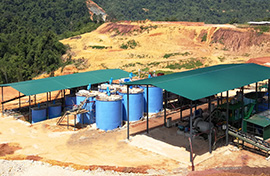-
 E-mail
xhcnlite@ytxinhai.com
E-mail
xhcnlite@ytxinhai.com
-
 Call Us
008617307193314
Call Us
008617307193314
 E-mail
xhcnlite@ytxinhai.com
E-mail
xhcnlite@ytxinhai.com
 Call Us
008617307193314
Call Us
008617307193314
2020-02-28 Views: 8880
Warm Tip: If you want to know more information, like quotation, products, solutions, etc., please Click here ,and contact us online.

With the development of beneficiation technology, the definition of refractory gold ore is changing. Generally speaking, refractory gold ore in leaching field is a kind of ore whose leaching rate of gold is less than 80% when directly processed by cyanidation after find grinding.
The reasons why gold ore is refractory are various, among which the physical encapsulation and chemical interference of minerals on gold are two important factors that hinder the process of gold cyanidation.
Gold is often wrapped in the main mineral, and the fine and scattered gold is especially wrapped in sulfide minerals (such as pyrite, pyrrhotite, chalcopyrite, antimonite, etc). Because of the gold particles in the ore are too fine and scattered, gold cannot be effectively dissociated from other minerals by ordinary crushing and fine grinding, which results in gold being unable to contact with the cyanide leaching solution and cannot be dissolved.
The gold cyanidation is often affected by the main mineral in gold ore. The way and extent of impact will vary with different minerals.
(1)Arsenic Minerals
Common arsenic minerals in gold ore are arsenopyrite, realgar and orpiment, among which arsenopyrite is most common.
The arsenopyrite oxidation reaction occurs in alkaline solution in presence of air, which consumes large amounts of oxygen so as to impact gold cyanide process:
4FeAsS+4Ca(OH)2+11O2→4FeSO4+4CaHAsO3+2H2O
Besides, a layer of arsenic compound is formed when the arsenic mineral is oxidized, which hinders the process of gold cyanidation directly.
(2) Iron Sulfide Mineral-Pyrite
The pyrite in solution will produce ferrous sulfate during oxidation. The interaction between ferrous sulfate and cyanide will generate ferrous cyanate, which will cause a large consumption of sodium cyanide.
2FeS2+7O2+2H2O→2FeSO4+2H2SO4
FeSO4+6NaCN→Na4Fe(CN)6+Na2SO4
Meanwhile pyrite in the pulp will produce soluble sulfide or thiosulfate under the action of lime and air. These reactions will lead to an increase in oxygen consumption. It can be seen that iron sulfide mineral is not conducive to the process of gold cyanidation.
With the increase in gold demand and the large-scale mining of gold, gold with high grade and quality as well as easy access to exploit is decreasing, the proportion of refractory gold ore is larger than ever before. Statistics show that the proportion of refractory gold ore is as high as 60% -70% of the total reserves in the world's gold ore. But the proportion of gold production from refractory ore is just about 30% of the total gold production in the world. As the refractory gold resources have not been utilized well, countries around the world attach great importance to the exploitation and utilization of refractory gold ore and the research on refractory gold extraction process.
At present, the ways to solve the problem of refractory gold ore are mainly the following three aspects:
(1)To oxidize and decompose the main mineral (mainly sulfide mineral) associated with the gold ore by pretreatment of gold ore before cyanidation, so that the encapsulated gold is dissociated and exposed, and some mineral components that interfere with gold cyanidation process are removed.
(2)Suppress or eliminate the interference of harmful mineral components in the process of gold cyanidation by adding certain chemicals or reagents.
(3)Using eco-friendly gold leaching reagent with high efficacy and low toxicity to solve environmental problems in the process of gold cyanidation. Compared with traditional leaching reagent, the eco-friendly gold leaching reagent has many advantages for some complex refractory gold ore processing, such as high leaching rate, low pollution, low cost of reagent, strong gold solubility, good stability, convenient storage and transportation, etc. CNLITE gold leaching reagent is such a eco-friendly reagent that not only overcomes the limitation of the application conditions, improves the leaching effect, but also shows better environmental benefits, thus can be widely promoted in gold leaching industry.
No. 188, Xinhai Street, high-tech Industrial Park, Fushan District, Yantai, Shandong, China.

Please leave your message here! We will send detail technical info and quotation to you!